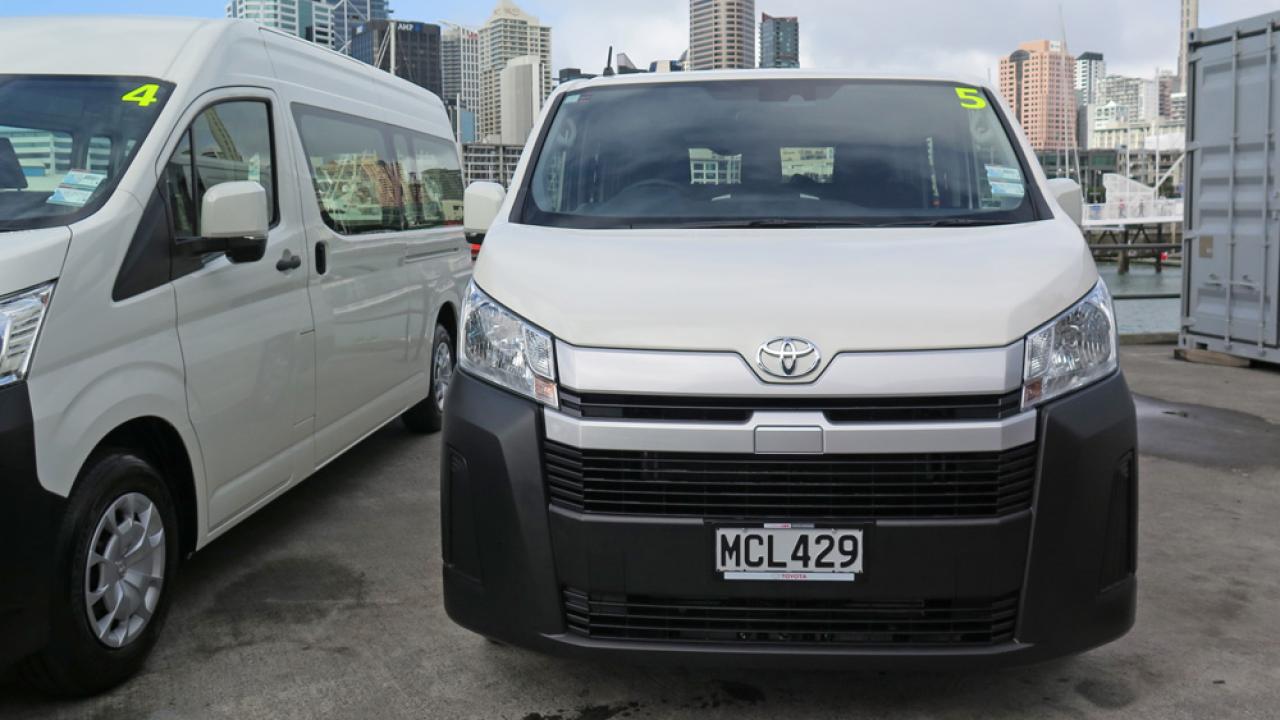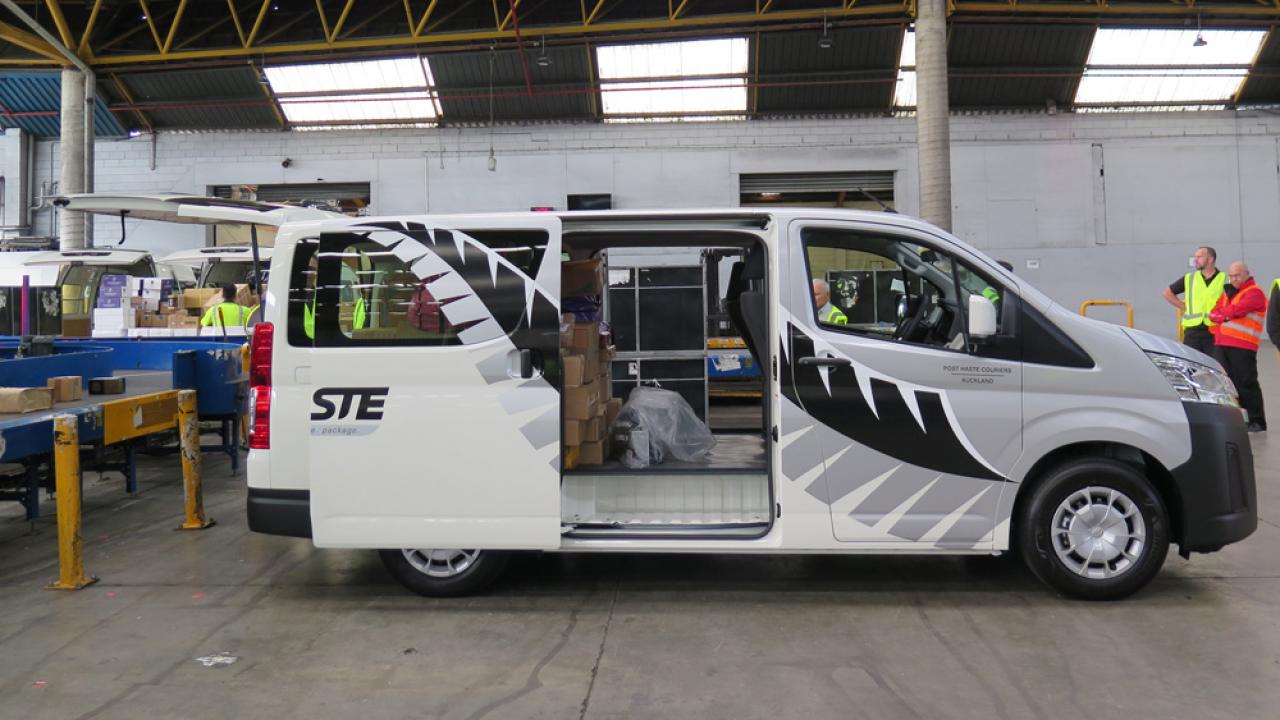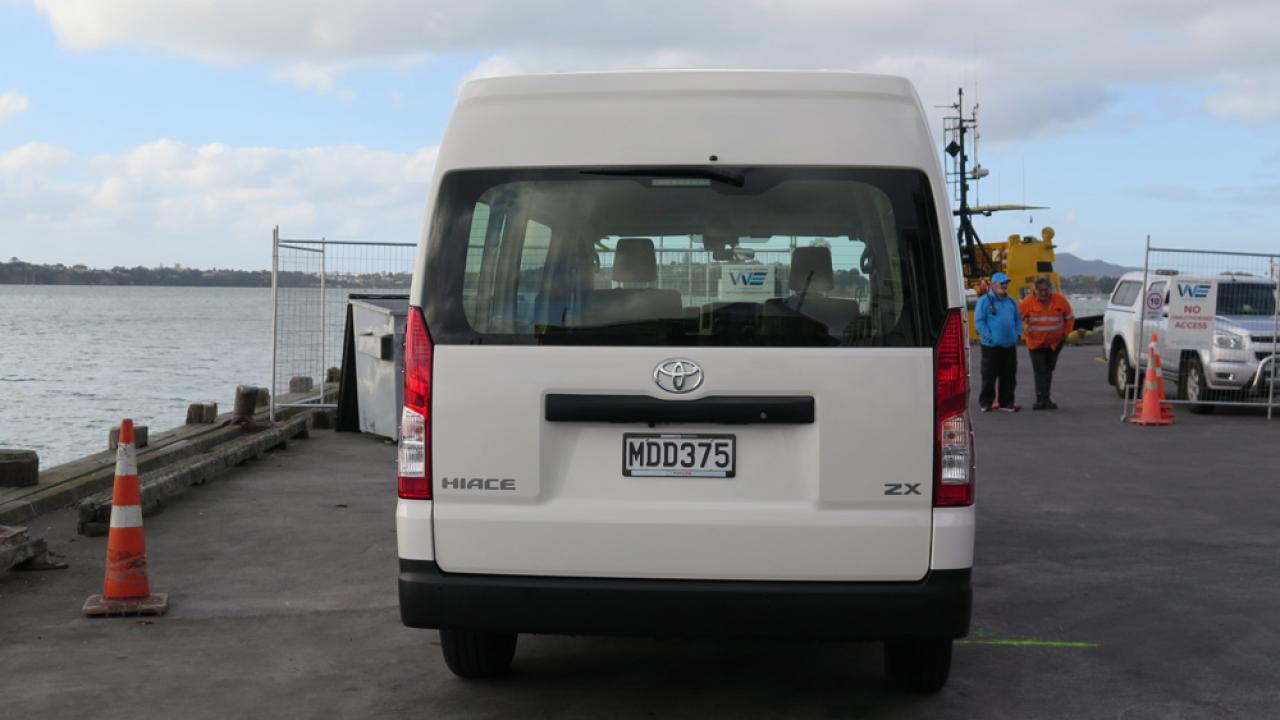It’s been 14 years since the outgoing Hiace first hit our roads, and this is just the fifth generation since the model launched in 1967.
We say outgoing, but in fact Toyota will keep some of the ‘old’ 3.0-litre vans. But joining them is this new Hiace, with a dramatic boost in spec and a couple of very visible changes.
This generation is considerably wider than its predecessor – very noticeable when following it from behind – and there’s that prominent nose, the departure from the typical flat front imparting several advantages. It’s safer – as the driver sits further from any frontal impact, and the crumple zone is larger; it’s more comfy, because the driver no longer sits over the engine and front axle but behind them; ingress and egress is easier, assisted by a better-placed step; and wheelbase is longer, so exterior length is up by 570mm for the ZR, to 5265mm, and by 535 for the ZX, to 5915mm.
That width means a piece of gib or a pallet will fit between the wheel arches.
All new Hiace have a height-adjust driver seat and a telescopic adjust steering wheel, and there’s more cabin storage, especially between the front seats, thanks to the wider body – a feature likely most useful to couriers.
There’s also been a dramatic step up in tech, not least within the cabin, where there’s a seven-inch touchscreen audio with satnav, mobile assist, Bluetooth and voice recognition, while the instruments include a digital speedo.
This Hiace should be a lot safer than it’s four-star predecessor too. A lower belt line and larger fixed glass areas on the front doors improve vision out, for starters, and then there’s the Toyota Safety Sense package. Standard across the new Hiace range, it includes auto emergency braking, also recognising cyclists and pedestrians. There’s lane departure alert, yaw assist and vehicle sway warning, auto high beam and trailer sway control, blind spot monitor and rear cross traffic alert, plus road sign assist and cruise control, to help cut speeding infringements.
The above should also cut fender-benders, which take a vehicle and its driver off the road, further assisted by the reversing camera plus front and rear park sensors.
The new line-up includes five variants, among them two body sizes, two body types and three passenger-seat configurations, while two versions will carry over, the ZL two-seater cargo van with auto or manual transmission, and the ZX 12-seater minibus.
There’s a minibus in the new Hiace body too, but it’s a 10-seater. Otherwise you’ve got four ZRs – a two-seater with full glass windows and an auto trans, the 10-seat auto with half glass and solid panels, a 10-seater auto with full glass, rear cooling and heaters plus extra speakers (both 10-seat models with single left-hand sliding cargo door), and two- or five-seaters with dual sliding doors.
As well as being longer than the outgoing version the ZX is 5mm lower, that fractional amount likely to still be noticed by those having to heft less far when loading. It features two seats, full glass windows and a left-hand sliding cargo door.
The all-new Hiace employs the same 2.8-litre turbo diesel as found in the Hilux, with 130kW and 420Nm (manual) or 450Nm (auto), more power and considerably more torque than before. Auto stop-start is a feature, to help save fuel.
Other spec varies, with up to nine airbags for some.
Toyota boasts this Hiace feels like a car to drive. Naturally that’s not quite the case – it’s still a van. However, the cabin is very easy to get comfy in – our short launch drive was shared between one driver over 1.8m tall and one considerably shorter, and both were able to get comfy. The seat base is flattish to help occupants slide in and out more easily, though the subtle side bolstering for the back will only be noticed by those with wide torsos.
The cabin ergonomics are good, the variants we drove delivered plenty of easy-to-reach storage, and the engine was naturally understressed at the modest speeds we went, unladen. First impressions of the ride (empty) were also good, and certainly it’s easy to forget just how large this Hiace is, until you realize you’re looking down into full-size ute cabs, or you try to park in a packed city environment. Turning circle was tight enough for an urban Auckland U-turn, at 11.8m (body) for all but the ZX, at 13m. The gearbox worked well, all-round visibility seemed reasonable, and those safety additions you’ll use regularly – like blind-spot warning – worked as billed.
It’d take a longer drive to test it in full, or see how the auto LSD works, and even the Freightways courier we spoke to who’d bought one – 82 per cent of the company’s owner-drivers have Toyotas – had only had it a week so far.
Fleet and business sales makes up a huge chunk of NZ’s new-vehicle market, with about 66 per cent, compared to 20 per cent in the US and 56 per cent in the UK. That trend started back in the 1970s and 1980s, when very high NZ tax rates meant a company car instead of a pay rise could avoid a boost in tax – especially as there was no Fringe Benefit Tax at the time.
By the 1990s the floodgates had opened to used imports, a factor that’s unusual in western markets. The private buyer shifted en-masse to the used import market, leaving new-vehicle buys to businesses.
Toyota sells to those businesses from the size of Transpower down to owner-driver couriers, such as those working for Freightways.
Large fleets focus both on ownership costs – buying, running, filling and maintaining – and safety, to conform to increasingly stringent Health and Safety Regulations. Owner drives may have slightly different requirements – Toyota says this Hiace aims to please both.
Either way, any owner also focuses on how well the van fulfills their needs. Hiace currently holds a third of the van market here – it’s topped its segment now for 25 years. By introducing the new version, while backing it up with three of the outgoing faves, Toyota plans to continue to dominate this segment of our roads.
|
At a glance |
|
|
Models |
Toyota |
|
Engine |
2.8-litre common rail turbo-diesel |
|
Price |
$44,990 to $56,990 |
|
ANCAP safety rating |
5 |
|
Power and Torque |
130kW at 3400rpm, 420Nm at 1400-2600rpm |
|
Transmission |
Six-speed manual, six-speed auto |
|
Fuel economy |
7.5l/100km (manual 2.8 glass van two-seat), 8.2l/100km (auto 2.8 glass van two-seat), 7.7l/100km (ZR 10-seat minibus), 8.4l/100km (ZX glass van) |
|
Towing capacity |
1900kg braked (2.8 glass van two-seat manual), 1500kg (auto 2.8 glass van two-seat) |
|
2WD/4WD/AWD |
Rear-Wheel Drive |
|
Seating capacity |
Between two and 12 depending on spec |
|
Luggage capacity/payload |
6.2 cubic metres/1020kg (2.8 glass van two-seat manual), 6.2 cubic metres/1030kg (2.8 glass van two-seat auto), 950kg payload ZR half panel van five-seat auto), 9.3 cubic metres/1170kg (ZX glass van auto) |
Safety systems
- Seven airbags
- Blind Spot monitor
- Rear Cross Traffic Alert
- Adjustable speed limiter
- Trailer Sway Control
- Reversing camera with dynamic guidelines
- Two front, four rear






